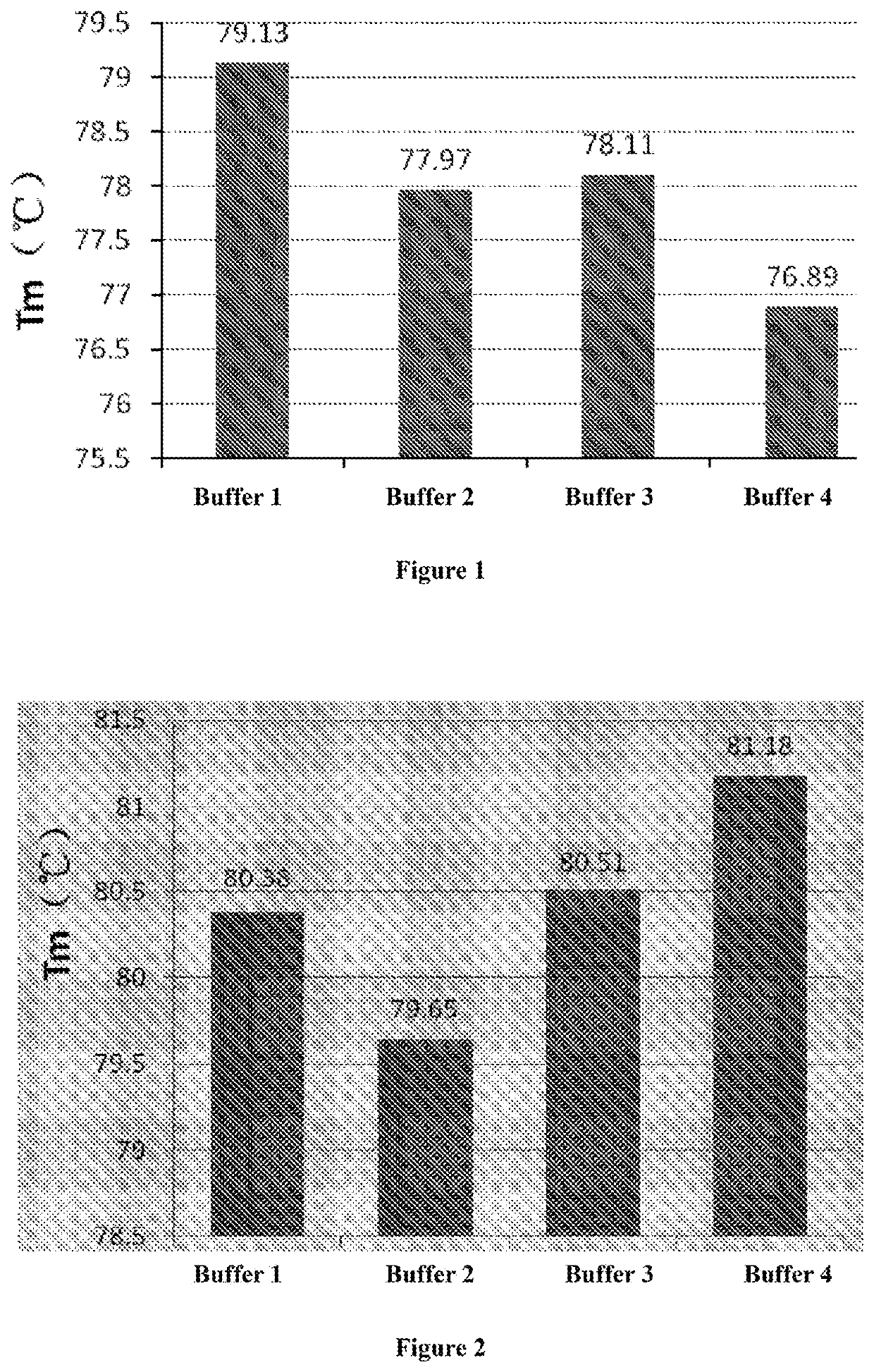Stable anti-PD-1 antibody pharmaceutical preparation and application thereof in medicine
a technology of anti-pd-1 antibody and pharmaceutical preparation, which is applied in the field of pharmaceutical preparation, can solve the problems of difficult formulation into a clinically feasible preparation, and the instability of new anti-pd-1 antibodies, and achieve the effect of stable anti-pd-1 antibody formulation
- Summary
- Abstract
- Description
- Claims
- Application Information
AI Technical Summary
Benefits of technology
Problems solved by technology
Method used
Image
Examples
example 1
[0095]The anti-PD-1 antibody was formulated as a preparation at pH 4.8-5.6 containing 10 mM (sodium) acetate, 90 mg / mL α,α-trehalose dihydrate, 0.2 mg / mL polysorbate 20, respectively. The antibody protein concentration was 40 mg / mL. Each formulation was filtered and filled into a 20 mL neutral borosilicate glass syringe bottle at 5 mL / bottle for lyophilization, the glass bottle is sealed with a halogenated butyl rubber stopper which was used for injection and lyophilized sterile powder. The lyophilized product was stored at 25° C. and 40° C. for stability analysis. The results showed that the anti-PD-1 antibody was very stable at pH 4.8-5.6.
[0096]
TABLE 1The effect of pH on the degradation of anti-PD-1 antibodyStorage conditionspHpHpHpHpHTest indexand time4.85.05.25.45.6SEC0 point98.097.997.997.997.9monomer40° C., 35 Days97.397.597.697.697.4(%)25° C., 30 Days97.697.797.897.897.8IEC main0 point66.266.466.666.466.4peak40° C., 35 Days64.764.164.765.965.3(%)25° C., 30 Days64.765.665.665....
example 2
[0097]In the following buffer solutions, anti-PD-1 antibody formulations with a protein concentration of 1 mg / ml were prepared.[0098]1) Buffer 1: 10 mM (sodium) acetate, pH 5.0;[0099]2) Buffer 2: 10 mM disodium hydrogen phosphate (citric acid), pH 5.0;[0100]3) Buffer 3: 10 mM (sodium) succinate, pH 5.0[0101]4) Buffer 4: 10 mM (sodium) citrate, pH 5.0
[0102]The thermal stability of anti PD-1 antibody in each formulation was measured by the differential scanning calorimetry (DSC). Analysis of the thermal denaturation median temperature (Tm) of the medicine showed that the stability of anti-PD-1 antibody in acetate buffer salt system was clearly better than that in succinate, citrate, disodium hydrogen phosphate buffer system. The result was shown in FIG. 1.
example 3
[0103]The PD-1 antibody formulations comprising a protein concentration of 1 mg / mL and different saccharides of various concentrations were screened using DSC technology:[0104]1) Buffer 1: 10 mM (sodium) acetate, 90 mg / mL sucrose, pH 5.2;[0105]2) Buffer 2: 10 mM (sodium) acetate, 30 mg / mL α,α-trehalose dihydrate, pH 5.2;[0106]3) Buffer 3: 10 mM (sodium) acetate, 60 mg / mL α,α-trehalose dihydrate, pH 5.2;[0107]4) Buffer 4: 10 mM (sodium) acetate, 90 mg / mL α,α-trehalose dihydrate, pH 5.2.
[0108]Referring to FIG. 2, analysis of the Tm showed that the anti-PD-1 antibody had the best thermal stability when the concentration of α,α-trehalose dihydrate was 90 mg / mL.
PUM
| Property | Measurement | Unit |
|---|---|---|
| temperature | aaaaa | aaaaa |
| concentration | aaaaa | aaaaa |
| concentration | aaaaa | aaaaa |
Abstract
Description
Claims
Application Information
 Login to View More
Login to View More - R&D
- Intellectual Property
- Life Sciences
- Materials
- Tech Scout
- Unparalleled Data Quality
- Higher Quality Content
- 60% Fewer Hallucinations
Browse by: Latest US Patents, China's latest patents, Technical Efficacy Thesaurus, Application Domain, Technology Topic, Popular Technical Reports.
© 2025 PatSnap. All rights reserved.Legal|Privacy policy|Modern Slavery Act Transparency Statement|Sitemap|About US| Contact US: help@patsnap.com

